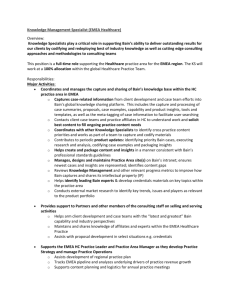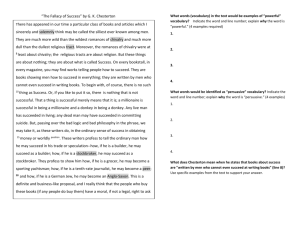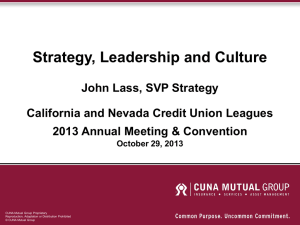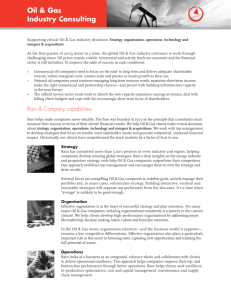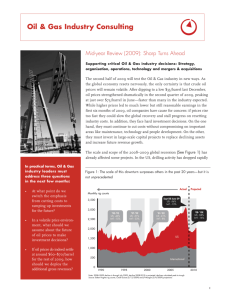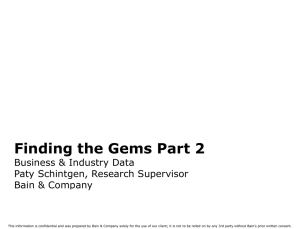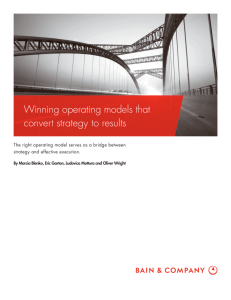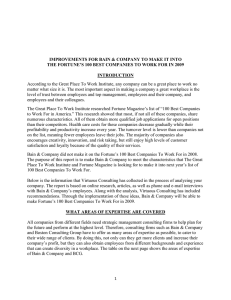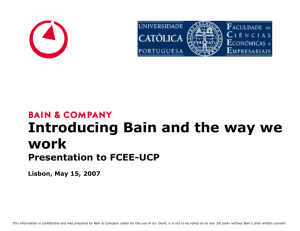FINAL2-Media D&D:Layout 1.qxd
advertisement
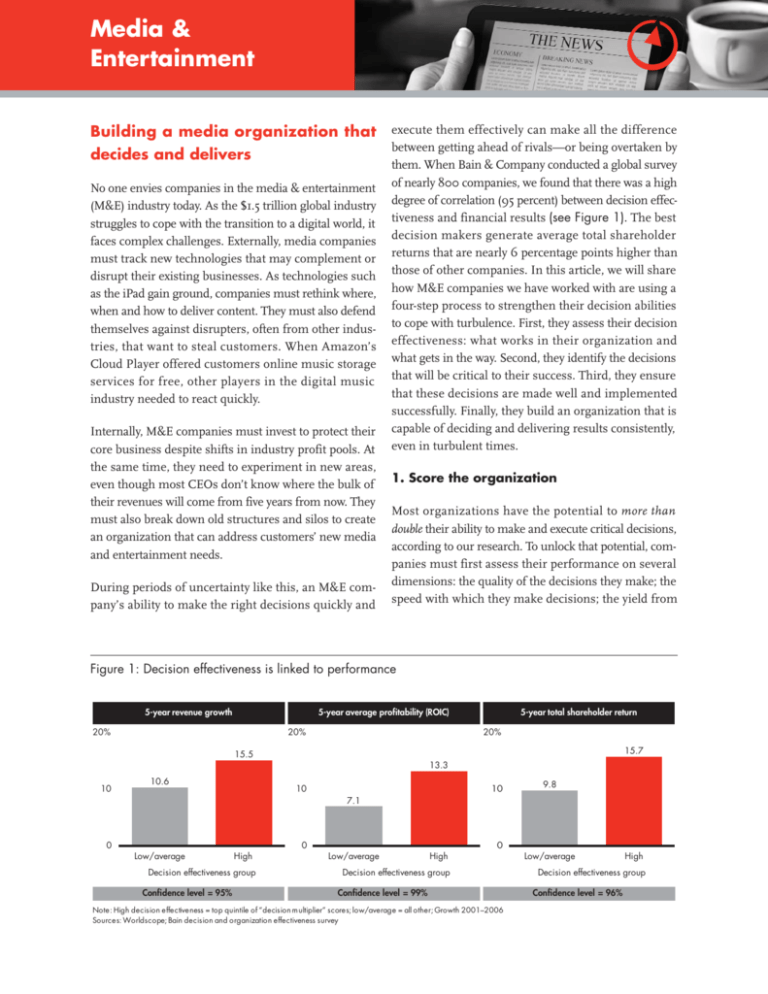
Media & Entertainment Building a media organization that decides and delivers No one envies companies in the media & entertainment (M&E) industry today. As the $1.5 trillion global industry struggles to cope with the transition to a digital world, it faces complex challenges. Externally, media companies must track new technologies that may complement or disrupt their existing businesses. As technologies such as the iPad gain ground, companies must rethink where, when and how to deliver content. They must also defend themselves against disrupters, often from other industries, that want to steal customers. When Amazon’s Cloud Player offered customers online music storage services for free, other players in the digital music industry needed to react quickly. Internally, M&E companies must invest to protect their core business despite shifts in industry profit pools. At the same time, they need to experiment in new areas, even though most CEOs don’t know where the bulk of their revenues will come from five years from now. They must also break down old structures and silos to create an organization that can address customers’ new media and entertainment needs. During periods of uncertainty like this, an M&E company’s ability to make the right decisions quickly and execute them effectively can make all the difference between getting ahead of rivals—or being overtaken by them. When Bain & Company conducted a global survey of nearly 800 companies, we found that there was a high degree of correlation (95 percent) between decision effectiveness and financial results (see Figure 1). The best decision makers generate average total shareholder returns that are nearly 6 percentage points higher than those of other companies. In this article, we will share how M&E companies we have worked with are using a four-step process to strengthen their decision abilities to cope with turbulence. First, they assess their decision effectiveness: what works in their organization and what gets in the way. Second, they identify the decisions that will be critical to their success. Third, they ensure that these decisions are made well and implemented successfully. Finally, they build an organization that is capable of deciding and delivering results consistently, even in turbulent times. 1. Score the organization Most organizations have the potential to more than double their ability to make and execute critical decisions, according to our research. To unlock that potential, companies must first assess their performance on several dimensions: the quality of the decisions they make; the speed with which they make decisions; the yield from Figure 1: Decision effectiveness is linked to performance 5year revenue growth 5year total shareholder return 5year average profitability (ROIC) 20% 20% 20% 15.7 15.5 13.3 10 10.6 10 10 9.8 7.1 0 0 Low/average High Decision effectiveness group Confidence level = 95% 0 Low/average High Decision effectiveness group Confidence level = 99% Note: High decision effectiveness = top quintile of “decision m ultiplier” scores; low/average = all other; Growth 2001–2006 Sources: Worldscope; Bain decision and organization effectiveness survey Low/average High Decision effectiveness group Confidence level = 96% their decisions—that is, how well they’re executed; and the effort that goes into decision making. One tool that helps managers identify where decisions are smooth or breaking down is a “decision X-ray.” Based on team surveys, interviews and in-depth analysis, the tool exposes trouble spots and pinpoints areas of improvements. M&E companies use the decision X-ray to review areas such as: • Structures and coordination: Does our organization structure allow us to maximize the full potential of digital opportunities—now as well as in the future? Is the organization exploiting cross-platform opportunities? Are silos getting in the way? • People and capabilities: Does our organization have the talent and skills to succeed with new formats, attract new customers and fend off new competitors? Do we have the right job descriptions in place? Are we hiring the right people? • Roles and processes: Do clear roles and responsibilities exist for making key decisions? Do our decision-making processes allow the company to adapt quickly to change, or slow things down with rework? • Culture and behaviors: Is our culture nimble and adaptable? Can we seize opportunities quickly or do we get paralyzed in the face of uncertainty? A large US newspaper company used the decision X-ray to figure out exactly what it needed to change to integrate its print and digital salesforce. Most top management discussions focused on the right threats—new competitors, the pressure on the bottom line and the need to shift to a new content and distribution model—but the team still struggled to implement change. The decision X-ray helped focus the conversation on what wasn’t working in terms of integration. It became clear, for example, that to create an integrated print and digital salesforce, the company needed to change the organization culture and encourage print “order takers” to become online “ad hunters.” 2. Focus on key decisions Given the growing number of complex decisions an M&E company must make in these fast-changing times, leaders must be clear about the most important decisions they have to make. These are the 15 to 20 big, high-value, strategic choices an organization needs to make for a smooth transition to its digital era business model. For M&E companies, critical decisions cluster in these areas (see Figure 2): • Capitalizing on the digital transition: As they redefine their business models, M&E companies must identify where they want to fit into the emerging digital media landscape. What type of content will they offer? Who will own it? What will be the right pricing and distribution for the content? It was in response to these questions that in 2011, the New York Times decided to move to a new subscription model where the most deeply engaged online readers are asked to pay to access content if they are not already print subscribers. • Extending the current business into logical adjacencies: As mobile devices, video games and live experiences proliferate, companies must decide which technologies will offer the best opportunity to generate revenues in the future. When faced with new digital technologies, Netflix quickly moved from mail-order delivery to online distribution. It struck innovative deals, for instance with Microsoft, to offer movies through the Xbox 360 gaming platform. • Realigning the cost structure to meet the new business needs: Companies need to adjust expenses to Figure 2: Media & entertainment companies face critical decisions due to industry turbulence How to capitalize on the digital transition? How to minimize losses in the core legacy business? How to realign the cost structure to meet new business needs? Strategic priorities for M&E companies How to extend the business into logical adjacencies? match the shifts in revenue and find ways to reduce fixed costs. For example, traditional newspaper companies “reinvented” the newsroom to focus more on online reporting. It helped reduce costs as well as provided customers 24/7 news coverage. • Protecting the core legacy business: Companies must stay true to their core values—especially those that customers appreciate them for. That requires retaining the best of their legacy businesses and discarding what is outdated in the digital age. The Walt Disney Company restructured its organization to capitalize on digital distribution, but it remained true to its mission to develop quality content. out, everyone on the team knows who's accountable for what. When a European TV broadcaster merged five independent broadcasters into one entity, it avoided potential conflict by first identifying decision roles and responsibilities for every manager. The new job descriptions prepared them to execute their roles in the new organization structure. • Understand the How: Will the decision be made by consensus, by vote or by one person? Can the group agree on criteria for the decision in advance? Will there be more than one real alternative presented? Answering questions like these enables decisions to proceed more smoothly. Once a US-based Internet company identified its major decisions, it then defined the process for making each decision as well as the “escalation path” for any issues getting in the way. For example, the global team responsible for managing key clients developed a detailed process on how to make efficient decisions in critical areas like account planning, proposals and negotiations. • Make the When explicit: Every major decision needs timetables and deadlines. Drawing up a schedule ensures that decisions are quickly followed by action. An incumbent telecom operator found that it was efficient while making long-term investment decisions. But when it came to decisions in the online content business, the company just did not react quickly enough. To speed up decision making, the “decision rights” for the content strategy were assigned to different stakeholders—the CEO, business units heads and function heads—with clear deadlines for each. Forced to respond to the timetable, the company’s processes worked smoother than before and its online business grew significantly. Armed with a clear view of critical decisions as well as organizational obstacles, M&E companies can increase their chances of success. They can implement change where it matters the most. 3. Make each decision work Once a company has drawn up a set of priorities, it needs to reset those decisions that are not working. It's like a surgical intervention: you go in and repair the trouble in order to restore the patient to health. We think of this operation as fixing the What, Who, How, and When of the decision. • • Clarify the What: The group involved in the decision first needs to know exactly what the decision is. It has to be spelled out clearly and framed correctly. For example, a leading US media company struggled to create the right structure with which to expand into international markets. Only when the organization framed the decision as “what structure will allow us to best focus on customer needs” could it identify the right model: a sales and marketing structure for each region. Determine the Who: The roles involved in making and executing the decision need to be clear too. We use a decision rights tool we call RAPID®, which includes all the key roles. One person or group makes the Recommendation. Others provide Input. Still others must Agree, or sign off on the recommendation. One person or group then has the D— and makes the final Decision. Others are assigned to Perform or execute it. Once the roles are spelled 4. Build an organization that supports decisions M&E sectors are in varying states of transformation. Companies in businesses such as newspapers and music must completely transform themselves to survive. Others, in growing businesses like broadcasting and online, need to stay ahead of disruptive changes. Both require getting not just the critical strategic decisions right but also the seemingly small operating choices made every day by people throughout the business. Creating such an organization requires scrutinizing and improving where necessary both the hard elements of the organization, such as structure and processes, and the soft ones, such as people and culture. Take the case of an Internet services company that wanted to deliver quality online experiences to customers. The new management simplified the organization structure, but the new roles and processes did not yield efficiency. Business groups that had long worked in silos did not trust one another. People who needed to collaborate ended up in conflict. Performance improved only when the company defined processes for how groups should work together and created metrics to evaluate the impact of decisions. Today, the CEO manages the global organization through just one profit-and-loss statement and decision-making roles and responsibilities are clear across the organization. Once companies master these four steps, they must ensure that the change sticks. Some companies consider this is so important, they think of it as the fifth step: working to embed new decision-making skills and tools throughout the organization. Sustaining transformational change is never easy—especially in the M&E industry where technology evolves and competitive forces grow by the minute. But it’s in just such a turbulent environment that smart and speedy decisions matter most. Cultivating the ability to make quick, effective decisions and implementing them efficiently gives companies more than a chance to survive; it creates winners that deliver sustained and superior performance. RAPID® is a registered trademark of Bain & Company, Inc. Key contacts in Bain’s Global Media & Entertainment practice are: Americas: Domenico Azzarello in San Francisco (domenico.azzarello@bain.com) Pedro Cordeiro in Sao Paulo (pedro.cordeiro@bain.com) Paul DiPaola in New York (paul.dipaola@bain.com) John Frelinghuysen in New York (john.frelinghuysen@bain.com) Andre James in Los Angeles (andre.james@bain.com) Ron Kermisch in Boston (ron.kermisch@bain.com) Charles Kim in New York (charles.kim@bain.com) Mark Kovac in Dallas (mark.kovac@bain.com) Rob Marcolina in Los Angeles (rob.marcolina@bain.com) David Sanderson in Los Angeles (david.sanderson@bain.com) John Senior in New York (john.senior@bain.com) Paul Smith in Boston (paul.smith@bain.com) Asia: Chris Harrop in Sydney (chris.harrop@bain.com) Tom Shin in Seoul (tom.shin@bain.com) Europe: Laurent-Pierre Baculard in Paris (laurent-pierre.baculard@bain.com) Alex Bhak in London (alex.bhak@bain.com) Frederic Debruyne in Brussels (frederic.debruyne@bain.com) Dan Kuzmic in Amsterdam (dan.kuzmic@bain.com) Michele Luzi in London (michele.luzi@bain.com) For additional information, please visit www.bain.com



